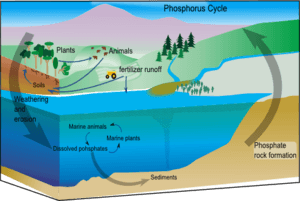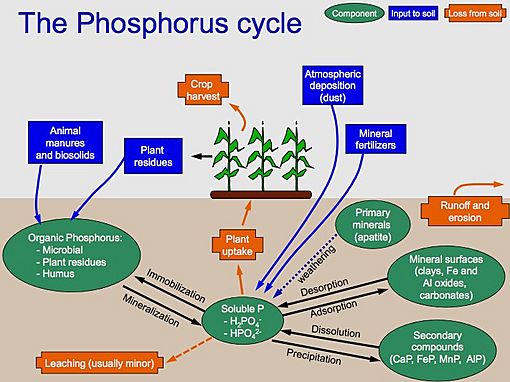Phosphorus cycle facts for kids
The phosphorus cycle explains how the important element phosphorus moves around our planet. It travels through rocks (the lithosphere), water (the hydrosphere), and living things (the biosphere). It's a natural process that keeps phosphorus available for life.
Contents
Phosphorus in Our World
Phosphorus is a super important nutrient for all plants and animals. It helps build key parts of living things, like DNA and cell membranes. In water, phosphorus can be a "limiting nutrient." This means its amount controls how much life can grow there. If there isn't enough phosphorus, organisms can't grow as much.
Most phosphorus stays on land, in rocks and soil. Only tiny amounts enter the air, like dust in rain or sea spray. About 80% of the phosphorus we dig up is used to make fertilizers for farming.
Phosphorus and Pollution
When too much phosphorus from fertilizers, sewage, or soaps gets into lakes and streams, it can cause pollution. This extra phosphorus can lead to huge growths of algae, called "algae blooms."
In fresh water, when these algae blooms die, they decay. This process uses up a lot of oxygen in the water. This can harm or kill other aquatic life, like fish. This problem is called eutrophication. The Canadian Experimental Lakes Area is one place where scientists have studied this.
It's important to know that algae blooms in saltwater, like in oceans and bays, are often caused by too much nitrogen, not phosphorus.
Where We Find Phosphorus
In nature, phosphorus is usually found as part of the orthophosphate ion (PO4)3−. This ion has one phosphorus atom and four oxygen atoms. On land, most phosphorus is locked away in rocks and minerals.
Over long periods, phosphorus-rich deposits form in the ocean. Then, geological processes, like the slow movement of Earth's plates, can lift these ocean sediments onto land.
When rocks and minerals break down from weathering (like from rain and wind), they release phosphorus. This phosphorus can then dissolve in water. Plants take up this dissolved phosphorus from the soil. They turn it into organic compounds, which are parts of their own bodies.
Animals then eat these plants. The phosphorus either becomes part of the animal's body or is passed out as waste. When plants and animals die, their bodies decay. The phosphorus returns to the soil. A lot of this phosphorus then turns into forms that don't dissolve easily. Some phosphorus can be carried by runoff (water flowing over land) back into the ocean. Over thousands of years, soils can lose a lot of their phosphorus, which can make ecosystems less healthy.
How Phosphorus Cycles
The phosphorus cycle is a slow journey that takes millions of years. Here are the main steps:
- From Land to Water: Phosphorus from rocks, mountains, and fertilizers is washed by rain into nearby land and bodies of water.
- Through Living Things: Animals eat plants that have absorbed phosphorus. They then release phosphorus in their waste. This waste can eventually reach water as runoff.
- In the Ocean: Phosphorus moves through animals that live in water. It eventually settles on the ocean floor.
- Becoming Rock: The phosphorus, often as phosphates, becomes part of the sediment at the bottom of the water. Over vast amounts of time, this sediment turns into new rock.
- Mountains Rise: Over millions of years, normal geological processes can push the ocean bed upwards. This forms new mountain ranges.
- Cycle Starts Again: The phosphorus in these new mountain ranges is then washed off by rain into bodies of water. This is how the long cycle begins again.
Images for kids
See also
 In Spanish: Ciclo del fósforo para niños
In Spanish: Ciclo del fósforo para niños







